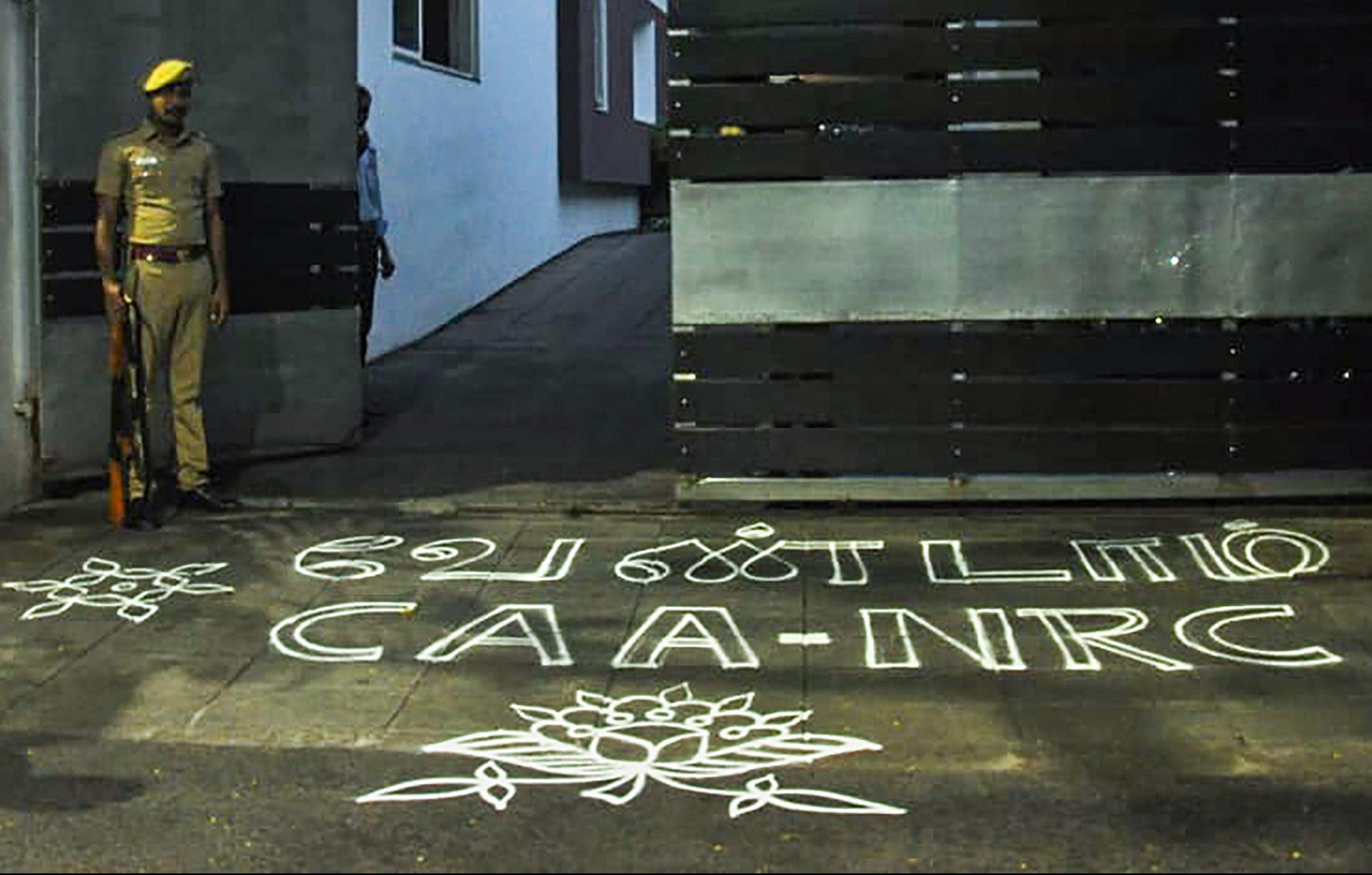
Kolams: A handful of rice flour, imagination, mathematics and history
Traditionally drawn on the threshold of a house or an establishment during ‘brahma muhurtham’ (time when gods descend), the kolam – designs made by hand using rice flour – is considered as the meeting point of the internal and the external. The ephemeral designs are also considered an offering for ants and insects.

Probably the oldest surviving form of piety, expression, communication and reverence the humble kolam has now turned into a medium to express dissent too.
Traditionally drawn on the threshold of a house or an establishment during ‘brahma muhurtham’ (time when gods descend), the kolam – designs made by hand using rice flour – is considered as the meeting point of the internal and the external. The ephemeral designs are also considered an offering for ants and insects.
Each dot, line, curve, interlinking design, circle, triangle and square, have a symbolic value representing the basic energies of the universe.
Also read | Houses of MK Stalin, Kanimozhi, Karunanidhi sport anti-CAA ‘kolams’
This tradition isn’t restricted to Tamil Nadu, says Anni Kumari, assistant professor, department of visual arts, Ashoka University. It is called rangoli in Karnataka, muggu in Andhra, sathaya in Gujarat, madna in Rajasthan, chowkpurna in Uttar Pradesh, pookalam in Kerala, aripan or alpana in West Bengal and chita in Odisha. “However, what makes kolams unique is that they are made by women. It is gender specific and is done every day before the crack of dawn and sometimes before sunset,” says Kumari.
Deeply entrenched cultural history
Meenakshi Devaraj, historian and researcher, says besides piety, sacredness is also an integral part of kolams. “For long, cow dung paste was smeared on the floor before beginning any religious activity. Earlier, rice used to be sprinkled at the entrance of homes. Eventually, the activity of sprinkling rice transformed into kolams. The practise is as old as wall painting and tattoos.
The earliest reference to kolams was found in Sangam literature (300 BCE to 300 CE). “In the 9th century, Vaishnavite saint and one of the 12 Alvars, Andal speaks of kolams in three places in Nachiar Tirumozhi (sacred sayings of the Goddess), a set of 143 verses. Manickavasagar, who wrote Shaivite hymns, has mentioned the use of ‘ma kolam’ made during Krishna Jayanthi. Most notably, the Kalingattuparani, a 12th-century Tamil poem and a war song by Jayamkondar, marking the victory of Kulottunga Chola I over the Kalinga king, talks about kolams too,” says Devaraj.
Also read | ‘Kolam’ protesters say police shoved them in; Stalin says anarchy on the rise
By the 19th kolam designs found its way into books in Tamil Nadu. Women began to share their designs with others, which encouraged them to learn and practise. “In fact, one of the books with kolam designs had a poem by a woman who calls upon others to get inspired and draw their designs to take them far and wide. Kolams lived through the Sangam period and survived through the Bhakti period too,” says Devaraj.
Kolam as a political expression
The rich cultural practise of kolams, has been used as a medium of political expression earlier too. The last significant one being 1975, when women across Tamil Nadu drew the rising sun – the party symbol of Dravida Munnetra Kazhagam (DMK) – as kolams. This has been documented by writer and independent researcher CS Lakshmi in her work, ‘Mother, Mother-Community and Mother-Politics in Tamil Nadu.’
It’s about mathematics too
Another fascinating facet of a kolam is the science and mathematics base on which these designs are built. The design is built on a grid of dots. “It is based on Fibonacci series, algebraic and numeric principles. Kolam epitomises geometrical properties of symmetry, periodicity, recursion and rhythm. It is amazing how some of these women who have no understanding of mathematics and the concepts, go about it,” says Lakshmi.
Generational value and communication
Udhaya Sankar, a designer and photographer, who has been working on kolam related images since 2001 says, oral tradition place a crucial role. “While I was researching, elders in some parts of Tamil Nadu told me that one would know if they have to extend an invitation for any auspicious event, depending on the kolam drawn outside. In Tamil Nadu’s Karaikudi belt, specific kolams were drawn to depict the gender of a newborn, in a way announcing the birth of a boy or a girl,” says Shankar.
The different forms of kolam
Padi kolam: Made on Fridays, the design is specifically drawn to welcome Goddess Lakshmi who represents wealth.
Chikku or sikku kolam: The curved lines around the dots are made in an intricate pattern. It is hard to find the start and end points of the pattern in this form.
Pulli kolam: With a grid of dots, the pattern is made around dots.
Welcome kolam: Using elements like lotus, conch and lamp, the kolam is made to welcome friends and relatives on special occasions.


